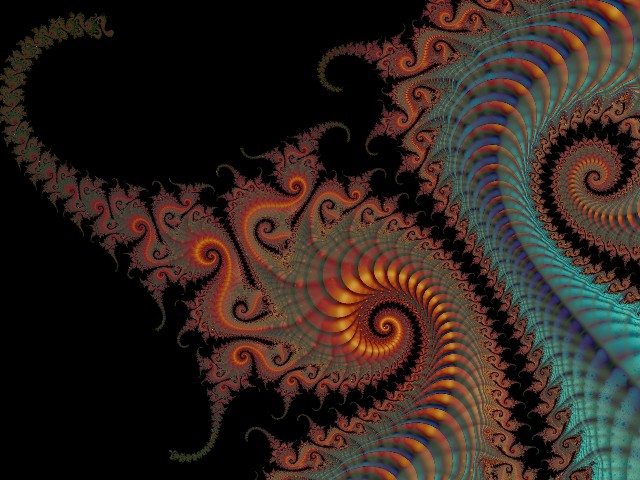

These are but three examples of the usefulness of the Alpha Channel. Not only does he maintain the golden rays of the top layer merged with the Phoenix Julia image below, they now alternate with rays of just the bottom layer's coloring. Frederik Slijkerman did just that for this image which also comes from the first Challenge (the goal of which is to explore the Alpha Channel feature). In some cases, you may have a specific idea in mind before you create a fractal and know that you'll need to use the Alpha Channel to achieve that effect. But just as frequently I open up the Alpha Channel editor for each layer (of course the bottom layer never has one!), add a control point, and then move it around just to see if there might be a hidden effect awaiting discovery. Sometimes when I'm creating a fractal I'll see a color I want to get rid of or a shape I want to emphasize and I'll use the Alpha Channel to achieve that goal. See the possiblities? I tweaked this image for HOURS before I settled on exactly the look I wanted! You'll notice that the changes effected are very subtle, but then to really have fun, open the Alpha Channel editor and try rotating it with the slider and moving the control points around. Once loaded, try toggling the top layer's Alpha icon off and on. In order to be able to appreciate the minute control that the Alpha Channel can give you you'll need to load the parameter file for this image. The bottom layer is on the left, top layer on the right: The only difference between layers is the outside coloring algorithm used for each. "Plastic Peekaboo" has two layers - both layers share the same formula, location and gradient. Let's start with a Challenge 1 entry by Damien Jones. If I may suggest, read through this whole page first, then load the parameter files for all three of these images which can be found here, and then go back through the tutorial again with the images open so that you can play and experiment with them along the way. Rather than talk you through creating an image that uses the Alpha Channel, I'm going to show you three images that demonstrate different ways and reasons to use transparency. At least that is how it has worked so far for me and a few other users I've polled. With rare exceptions, I think most users experiment with the Alpha Channel after they've begun working on an image - rather than planning ahead of time to use it in a particular way. Now what's the point? I've really thought long and hard about this question while writing this tutorial. Ok, so hopefully you're starting to understand how the Alpha Channel works. Quickly scan formula files and parameters with the new thumbnail view and the powerful search tools.Ultra Fractal Tutorial - When and Why to use the Alpha Channel Organize all your fractal-related files with the integrated Explorer-like file browsers. Simply select a coloring algorithm that contains an image parameter, and you can select any image on your computer to use.Ĭreate fractal animations easily with the powerful animation features Import PNG, JPEG or BMP images in your fractals with the built-in image import feature. You can also use the gradient editor to add transparency effects. Drag the gradient curves up and down to create smooth ranges of colors, or use the Randomize options to quickly try various color combinations. Experiment with new parameter values by moving the mouse cursor over a coordinate grid in the Explore window, while the Fractal Mode tool window shows a real-time preview of the result.Ĭolor your fractals and add transparency effectsĬoloring your fractals is easy with Ultra Fractal’s gradient editor. Tweak parameters with the versatile Explore featureĬhoosing parameter values is a breeze with the new Explore feature.

And thanks to the new perturbation calculations algorithm in Ultra Fractal 6, images that previously took hours or days to generate are now completed within minutes! Deep zooming is fully integrated and works with all fractal types and coloring options, even those you have written yourself. You can zoom to virtually unlimited depths with Ultra Fractal. With Ultra Fractal, you can choose from thousands of fractal types and coloring algorithms, zoom in as far as you want, use gradients to add color, and apply multiple layers to combine different fractals in one image. It is very easy to use and yet more capable than any other fractal program.


Ultra Fractal is a great way to create your own fractal art.
#ULTRA FRACTAL PARAMETER FILES INSTALL#
Yes, Ultra Fractal is safe to install on Windows 10.


 0 kommentar(er)
0 kommentar(er)
